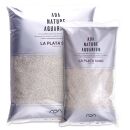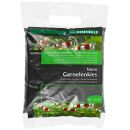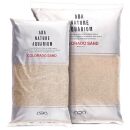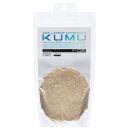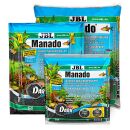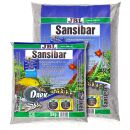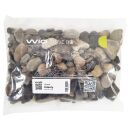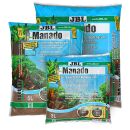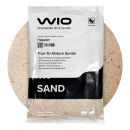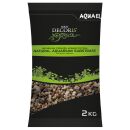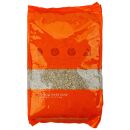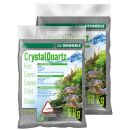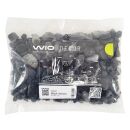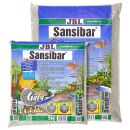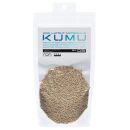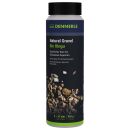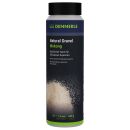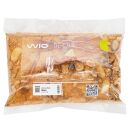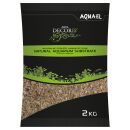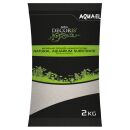- Produces a natural appearance
- Very light-coloured almost white sand
- Reflects the nature of a stream
- Very fine-grained (1-4 mm)
- Grain-size: 0.7 - 1.2 mm
- Black substrate
- No risk of injury due to rounded edges
- Hardener-free, CO2-proof, light-resistant, waterneutral
- Produces a natural appearance
- The warm colour tone suits the aquatic plants perfectly
- Slight reddish colour goes very well with driftwood
- Ivory-coloured decorative sand
- From the ADA KUMU series
- Grain size 0,4 - 0,85 mm
- High impact on GH
- Ideal for aquarium and terrarium layouts
- Water-neutral, dark brown substrate
- Grain size: 1,5 - 2,5 mm
- Ideal for burrowing fish species
- High iron buffer
- Black grey ground material for aquariums
- Very decorative ground material for aquarium and aqua-terrarium
- Grain size: 0,2 - 0,5 mm. Allows the keeping of Corydora
- Not so well suited for undergravel heating cables
- Natural riverbed substrate
- Especially rich in colour
- Can slightly harden the water
- In 3 different grain sizes
- Ideal for riverbed impressions
- Water-neutral, brown substrate
- Grain size: 0,5 - 2,0 mm
- Ideal for fish, invertebrates and plants
- High nutrient buffer
- Very bright colouring
- 100 % natural origin
- Varied grain size
- Natural substrate
- Without artificial additives and coatings
- Multicoloured gravel
- Natural look in the aquarium
- Substrate for aquariums
- Does not change the pH value or water hardness
- Beautiful natural colouring
- Includes different gravel sizes
- Hardener-free
- CO2-proof
- Light-resistant
- Grain size 1-2 mm
- Rounded edges protect bottom-dwelling fish
- Flat, rounded gravel
- From the ADA KUMU series
- Grain size 10 - 40 mm
- High influence on pH & GH
- Ideal for aquarium and terrarium layouts
- Natural riverbed substrate
- Anthracite to black
- Can slightly harden the water
- In 3 different grain sizes
- Ideal in combination with green plants
- Grey, fine ground material for aquariums
- Very decorative ground material for aquarium and aqua-terrarium
- Natural Material without any artificial additives
- Grain size: 0,2 - 0,6 mm. Allows the keeping of Corydora
- Not suitable for undergravel heating cables
- Natural dark sand colour
- From the ADA KUMU series
- Grain size 0,4 - 0,85 mm
- Moderate impact on pH
- Ideal for aquarium and terrarium layouts
- Ivory-coloured decorative sand
- From the ADA KUMU series
- Grain size 0,85 - 2 mm
- High impact on GH
- Ideal for aquarium and terrarium layouts
- Almost pure white sand
- From the ADA KUMU series
- Moderate impact GH
- High impact on pH
- Ideal for aquarium and terrarium layouts
- Yellow gravel with colour speckles
- From the ADA KUMU series
- Grain size 2 - 4 mm
- Moderate influence on pH and GH
- Ideal for aquarium and terrarium layouts
- Natural colourful gravel
- Grain size 2 - 22 mm
- Light and CO2 resistant
- 100 % natural origin
- Fine, bright sand
- Grain size 0,1 - 1,4 mm
- Light and CO2 resistant
- 100 % natural origin
- Inspired by the Malebo Basin in the Congo River
- 0,1 - 40 cm
- 100 % natural material
- Water neutral
- Ideal for river habitats
- Natural soil material
- Creates beautiful contrasts with dark shrimps
- Grain-size: 1,6 - 4,0 mm
- Available in 2 kg or 10 kg bags
- Natural soil material
- Creates beautiful contrasts with coloured shrimps
- Extremely fine grain size from 0.1 to 0.3 mm
- Very fine and light quartz sand
- Safe for underwater fish and Caridina shrimp
Sand or gravel - that is the question.
Sand and gravel haven been in use for a long time in aquaristics as substrates in aquariums. The difference between sand and gravel is in principle fluid and depends primarily on the average grain size. Sands are divided into fine, medium and coarse sand with grain sizes from 0,02 to 2 mm. Coarser material with a grain size of up to 63 mm is referred to as gravel, which is likewise divided into fine, medium and coarse.
When buying aquarium substrate you should always keep in mind, that there is a difference between completely natural substrates and those that are specially colored and coated with synthetic resin. The completely natural substrates include, for example, the classic quartz gravel from Dennerle, which is available in many different colors and behaves neutrally in the water, meaning that it does not emit anything into the water. Although natural substrates are usually prewashed, they may still contain dust due to their origin and of course due to possible friction and abrasion during transport. If those substrates are used, it is advisable to pre-clean it thoroughly by rinsing it with water. Usually thos sand and gravels behave neutrally in water. There are, however, a few exceptions which may cause the water to harden if e.g. the substrate contains lime. Should the substrate have water hardening properties, it will of course be noted in our webshop's product info. Unlike soil, sand and gravel substrates are completely free from nutrients. As an exception to that rule, the Flourite substrates from manufacturer Seachem need to be mentioned, offering sand and gravel substrates enriched with iron, trace elements and macronutrients. Aquatic plants profit from the supply of nutrients contained in the substrate, which thea are able to take in via their roots. The article Seachem Flourite at our Aquascaping Wiki presents these substrates in more detail.
As contrast to the dark substrate, mostly bright sands are used as decorative zones or paths in aquascaping. For the most natural impression possible, the aquarium designer often uses different grains of the same type of sand. This can be relized particularly well with the sand & gravel varieties of the manufacturer ADA. To scape and care for these decorative substrates, special tools - called Sand Flatteners - are used.
Many tropical aquarium fish like cories, discus as well as several species of South American and African cichlids prefer sandy substrates with finer grain sizes as they know them from their natural habitats. Often these fish will rummage through the substrate on the hunt for food, or they build hideouts and spawning grounds. In an aquarium, these animals therefore feel most comfortable with sandy substrates.


